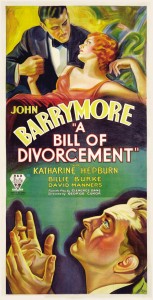|
Genres, Themes, Actors, and Directors:
- Divorce
- Father and Child
- George Cukor Films
- John Barrymore Films
- Katharine Hepburn Films
- Mental Illness
- Play Adaptations
Response to Peary’s Review:
Peary is spot-on in his lambasting review of this “stagy, hokey adaptation [directed by George Cukor] of Clemence Dane‘s bad play”. He accurately notes that “the overwrought characters take turns being the martyr”, without any relief in sight; indeed, for those who enjoy watching likable characters suffer (and/or Barrymore at his hammiest), this film should suit the bill nicely. On the plus side, Burke (in a substantial role) actually gives a reasonably nuanced performance, rather than resorting to her typically ditzy socialite mannerisms; knowing that she suffered the loss of her real-life husband (Flo Ziegfeld) during the filming adds gravitas to her portrayal. Meanwhile, Peary points out that the film “at least… has historical significance in that it featured skinny Hepburn’s screen debut”, and she alone makes it worth a one-time look. While producer David O. Selznick was apparently concerned that audiences wouldn’t take to Hepburn, she’s positively luminous here (thanks in part to gorgeous cinematography by Sidney Hickox); one can easily understand why she went on to become a major — if resolutely iconoclastic — Hollywood star.
Note: Hepburn’s creative collaboration with Cukor lasted throughout the next 17 years, resulting in a total of eight theatrical films, including the following titles: Little Women (1933), Sylvia Scarlett (1935), Holiday (1938), The Philadelphia Story (1940), Keeper of the Flame (1942), Adam’s Rib (1949), and Pat and Mike (1952).
Redeeming Qualities and Moments:
- Katharine Hepburn as Sydney Fairfield

- Billie Burke as Meg Fairfield

Must See?
No, though it’s worth a one-time look simply out of historical curiosity.
Links:
|



One thought on “Bill of Divorcement, A (1932)”
Not must-see – and rather in agreement with the assessment,
Whereas it’s probably true that, as a play in the time that it premiered, some of the content (i.e., divorce, hereditary insanity) may have been seen as controversial and perhaps even potent as stage material, there must certainly have been other plays of the period that were not as overtly melodramatic as this one. If the potential for borderline-camp wasn’t apparent at the time, the passing of time has made that more possible, making the material almost impossible to play.
So, no one in the cast is at an advantage here (with the occasional exception
of Burke, who does exhibit some nuance and restraint often enough). And no one is helped by Cukor’s lack of subtlety in direction. Barrymore is given free rein, for the most part, to over-do. In her first role, it’s a bit hard to see what Hepburn would become with time, as she grew more comfortable in front of the camera.
In short, when Barrymore tells Burke, “I’ll be your dog!”, we cringe at the script’s full-throttle (somewhat purple) hysteria. And when Burke tells him “I can’t stand this!”…well, we agree.